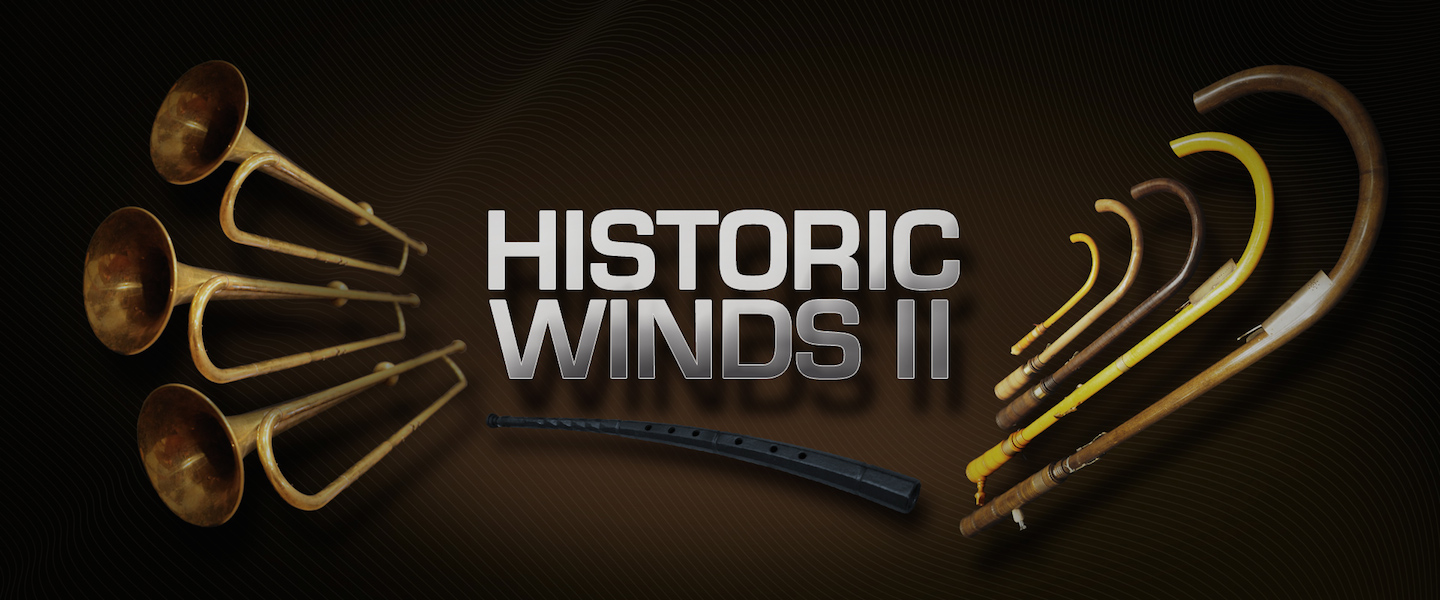
- Fanfares - Premiere Suite - Natural Trumpets
- Dignity and Honour - Natural Trumpets
- Hope - Natural Trumpet-Bb
- Camellia - Cornett
- Mille Regretz - Cornett
- The King's Decree - Crumhorns
- Now is the Month of Maying
Open External Player
HISTORIC WINDS II
Vienna Instruments Collection
Calculating your price
Related Products
Ancient Winds
The instruments of Historic Winds II are also available separately as SYNCHRON-ized Historic Winds Packs, re-edited, updated and optimized for the Vienna Synchron Player.
This Collection contains instrumental rarities that are not only perfectly suited to score appropriate film subjects but are a real source of inspiration if you’re looking for all-new timbres and instrumental combinations in order to enrich your arrangements with new colors. Historic Winds II includes recordings of nine rare instruments of the Renaissance and Baroque era: Cornett (zink), five crumhorns, and three natural trumpets.
The Cornett (or zink – not to be confused with the trumpet-like Cornet included in our Special Brass Collection) was a popular wind instrument of the Renaissance and Baroque periods. Its conical wooden pipe is about 61 centimeters (24 inches) long and covered in leather. There are no valves but six front finger holes as well as a thumb hole on the back, as on the recorder. The cup mouthpiece is usually made of horn, ivory or bone and it takes a lot of practice to achieve pure intonation. The cornett is a very agile instrument covering the soprano and sopranino registers with a key range of almost three octaves. Especially in the high register the timbre is reminiscent of a blend of a soft piccolo trumpet playing mezzoforte and a female voice. Famous composers who wrote for the cornett were Giovanni Gabrieli and his student Heinrich Schütz, whose sacral works for choirs usually feature an extensive instrumental accompaniment.
The Crumhorn’s name is derived from the German “Krummhorn”, which means “bent horn”. The lower part of the instrument is bent upwards in a curve like the letter “J” and the cylindrical shaped pipe has seven finger holes on the front and one on the back. Unlike recorders Crumhorns have a double-reed mouthpiece like the bassoon; it produces the typically bright and “nasal” timbre that music of the Renaissance period is often associated with. As a typical woodwind instrument of the Renaissance period the Crumhorn disappeared later in the Baroque era but was rediscovered in the 20th century in Folk, Medieval and contemporary music. As an example, composer Mauricio Kagel (1931–2008) used four Crumhorns in his “Music for Renaissance Instruments” (in memoriam Claudio Monteverdi). Crumhorns are available in various sizes, as the instrument’s range covers just one octave. Historic Winds II contains recordings of five different crumhorns, covering the soprano, alto, tenor, bass, and double bass register.
Natural trumpets were originally used as military instruments for acoustic signals. Although used in Venetian ceremonial music of the 16th century, the natural trumpets experienced their heyday in the Baroque period, when composers such as Bach, Handel, Vivaldi or Telemann created works for the instrument. Natural trumpets continued to be used throughout the Classical era and even into the early Romantic period. As they have no valves the instruments are characterized by their long tubing compared to modern trumpets. They can only produce notes of the natural harmonic series, from the 3rd to the 16th, of the corresponding key. Impure harmonics, such as the 7th, 11th, 13th and 14th note of the harmonic series, and even chromatic notes can be achieved with advanced “lipping” techniques (i.e., flattening or sharpening the tuning with changes in embouchure). Playing in the very high register is also known as the clarion technique (Latin: clarus = bright). The majority of Baroque trumpet parts were written for natural instruments pitched in Bb, C or D. We’ve recorded three different instruments in these keys to provide you with utmost flexibility.
| Library | |
|---|---|
| Sample Amount | 20,250 |
| Download File Size | 5.0 GB |
| Installed File Size | 8.5 GB |